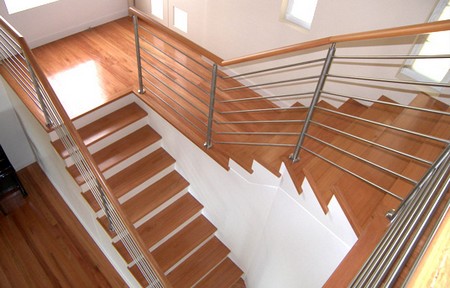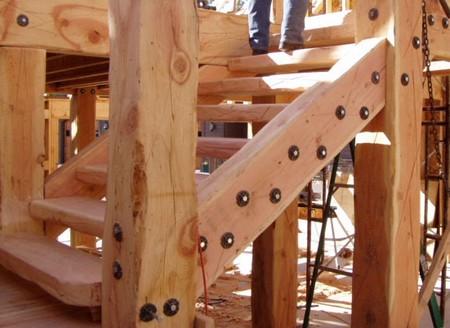The main defects found in timber stairs are: worn treads and nosings, creaking steps and loose, cracked and broken balusters and handrails. Worn treads are often the result of leaving the stair uncovered no carpet. The wear is usually on the edge of the nosing. Repair is simple cut out the worn section and splice in a new section. The section of limber removed should be about 50mm wide so that the replacement can be glued and screwed securely to the existing tread and riser. Use a jigsaw to cut out the tread.
Creaking steps may be caused by a number of things. The most common are loose or missing glue blocks, loose wedges, and a defective joint between a tread and the bottom of a riser. Staircases over 900mm wide often creak because the centres of the wide steps are not supported well enough. To identify the cause (or causes) of the problem, examine the underside of the staircase.

First check all the glue blocks to make sure that they are in position and securely fixed to both the tread and the riser. Replace any loose or missing glue blocks with new ones. There should be at least two glue blocks underneath each tread.
Now check all the wedges to sec if they have worked loose as a result of shrinkage. Any loose wedges should be glued and rewedged. Sometimes it is necessary to recut the wedges so that you can hammer them further in.
When it is impossible to gain access to the underside of the stair to carry out repairs to loose or missing glue blocks, it is often possible to eliminate the creaking by driving screws down through the tread into the top of the riser. Countersink the heads neatly.
Occasionally the joint between the tread and the bottom of a riser comes apart. This can be fixed by driving screws up through the underside of the tread into the riser three equally spaced screws are usually sufficient to secure the joint.
Missing, broken or loose handrails arc extremely dangerous and should receive immediate attention.
Small cracks in handrails can be repaired by squeezing glue into the crack and clamping the parts together in position. With large cracks and breaks it may be necessary to insert a length of dowel as well. When it is necessary to replace a section of a handrail, fix the new length to the existing handrail either by splicing them together and using dowels or by joining them together with handrail bolts and dowels.

Cracked and broken balusters can be repaired by gluing them together or by splicing them together with new timber. Obtaining replacements for the decorative balusters often found on older staircases can be quite difficult. So it may be necessary to repair even the most badly damaged baluster. New ones can be made, but this is expensive.